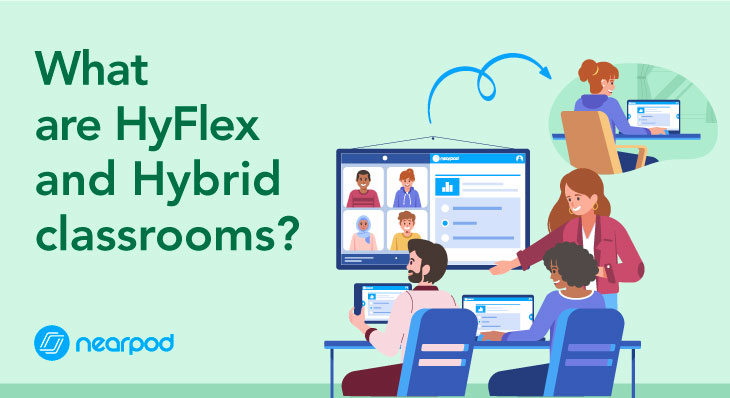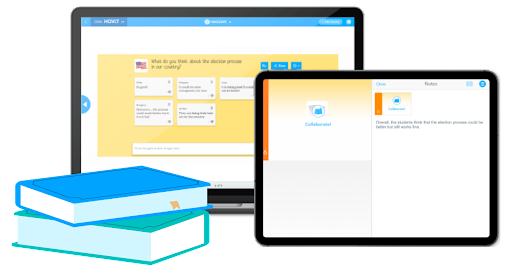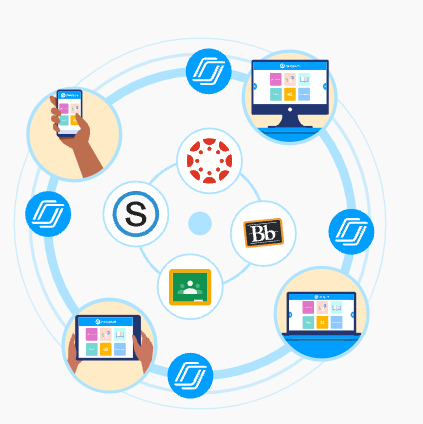
What are HyFlex and Hybrid classrooms?
Hybrid and HyFlex models of learning continue to be discussed, trialled, and implemented at institutions around the world as many of us return to work and school with a new normal, or look to the future to create a new normal. These education models are appealing to administrations for their ability to help ensure continuity during shutdowns. Students have reported a preference to flexible offerings over traditional content delivery (Paul, 2019). Are these options right for you as an educator? Are you ready to implement hybrid or HyFlex learning strategies?
Although the models of hybrid and HyFlex learning are gaining popularity, they evolved and had been implemented and researched long before the COVID-19 pandemic and physical distancing requirements shut down our classrooms and schools.

HyFlex Learning
The HyFlex learning approach is credited as originating at San Francisco State University approximately ten years ago by Dr. Brian Beatty, professor of Instructional Technologies. “HyFlex” represents Hybrid-Flexible and “consists of hybrid classes–blending online and on-site participation modes–that provide a more flexible learning experience to students” (Ferrero, 2020).
With HyFlex learning, educators create extremely versatile course content that allows students to access the material in-person or online, during or after scheduled class sessions. Unlike traditional lecture-style teaching which is educator-focused, HyFlex learning is designed to be student-focused.
Students decide on the best pathway for their education and can adjust as the course progresses. Students are active in their learning process and education experience through learner choice and “a student-directed, multimodal learning experience” (Beatty, 2019).
A HyFlex learning experience includes all the aspects of hybrid learning; however, the student decides which modality they would like to participate in. Educators create engaging materials that the student may participate in face-to-face synchronous with in-person (classroom), face-face synchronous through video conference (e.g. Zoom), or asynchronously through the institution’s Learning Management System (LMS).
A HyFlex learning model differs from hybrid learning as the students are provided multiple forms of content delivery, learning environments, and knowledge assessment resources. It should be noted that some schools, although promoting course offerings as HyFlex, do not include fully asynchronous options within their course delivery (Schulich, 2021).
Why Offer Hybrid or HyFlex Learning
Anecdotally, schools have always struggled with space issues. From our days in elementary school and portable classrooms, through high school staggered starts, to evening and weekend classes at college and university, administrators struggle with creative ways to allow more students to attend courses and institutions. Hybrid and HyFlex learning allow for schedulers to expand class sizes or offer more courses in the same number of classrooms.
Additionally, attending college or university is an overwhelming and expensive opportunity for many students. Looking around our classrooms, the diversity of our students has changed over time. The percent of adult learners enrolling in undergraduate programs continues to rise (NCES, 2021). Some students have to take time off from work and family to attend class. Not all students can afford to relocate to attend the program and school of their choice. How many individuals who want to attend are not able to, due to distance and time? We may never know; however, we do know that by offering a variety of options we can narrow this education divide. Through the implementation of hybrid or HyFlex learning, we can allow equal access to higher education regardless of location. Working full-time, with a family, I would not have been able to complete a Masters degree if my university did not offer a HyFlex delivery model.
Pros and Cons of Hybrid or HyFlex Learning Environments
As mentioned earlier, hybrid and HyFlex learning environments give students more choice in how and where they attend their courses. To ensure this flexibility, educators must build multi-modal content. Instructors need to rethink their content delivery strategies and how engagement with educators, content, and peers will occur within the hybrid or HyFlex learning environments. With HyFlex learning, rather than creating separate face-to-face content and online content, all content must be built to be delivered and acquired in any environment.
Particular focus must be given to principles of accessibility to ensure equal access for students, regardless of their participation modes. Universal Design for Learning (UDL) principles must be considered and utilized in course material design.
The largest disadvantage to hybrid and HyFlex learning is associated with adopting without readiness. If a school or educator moves too quickly to integrate these methodologies, then some students may not be given equal opportunity to interact with content and to learn. As an educator, I have seen the consequences of hastened early adoption of HyFlex learning. These consequences include students online unable to hear what is being discussed in-person, frozen video feeds, educators not adapting content but merely posting lecture slides online as asynchronous content, and more.
Institutions need to invest in resources to ensure each student has an equal opportunity to learn, regardless of how they join the class. HyFlex classrooms should be purpose-built or renovated as HyFlex spaces rather than expecting educators to adapt and make a traditional classroom work for HyFlex delivery.
The components of a HyFlex learning environment are explored in other blog posts and tech guides, and include elements to ensure the educator, in-person students, and online students can all see, hear, and interact together. Recommended components include a lavalier microphone, ceiling microphones, multiple video cameras, large monitors, and a demonstration/document camera.
Additionally, although this style of learning is convenient for students, it does require support and guidance to ensure student success. Educator support is crucial to adjust teaching habits for competency with all aspects, especially asynchronous engagement and synchronous with multiple modules eg. simultaneous chat.
How Nearpod Improves Hybrid or HyFlex Learning Environments

Nearpod is a solution for educators seeking a tool that enhances or serves as the foundation for a hybrid or HyFlex learning experience. I have had great experiences in my HyFlex courses when I build all lessons with Nearpod. A Nearpod lesson can be facilitated inside a classroom, online synchronously, or online asynchronously, which makes it the ideal platform for flexible delivery.
Matching learning objectives to the lesson, I can easily ensure engagement and interactivity by including Nearpod native content and activity tools in my lessons.
Some of my favorite content pieces are the Interactive Videos, Slides, Web Content, and Microsoft Sway integration. For activities, which make Nearpod unique in higher learning environments, I often utilize the Quiz, Draw It, Collaborate Board, and Flipgrid integration. Low stakes, high frequency assessments through the Quiz tool give the students and educator several touchpoints to ensure learners are progressing with the material as expected.

The Collaborate Board remains a favorite, and helps ensure the course material is a living and active document.
To ensure simple navigation pathways for students, Nearpod can be integrated with your institution’s LMS. The reports feature of Nearpod is impressively robust, and allows me to track student participation with engagement details, assisting with attendance and progression monitoring. Quiz results, Poll results, and Open-Ended Question results are added into the student grade book and I routinely post a PDF of the completed Collaborate Boards for students to review.
As a Nearpod PioNear I may appear biased; however, there is a good reason that I integrated this tool into my classroom in 2014, continue to use it, and have facilitated hundreds of lessons with the app—it works! I encourage you to start small and convert one of your hybrid or HyFlex lessons into Nearpod. Transfer your wonderful classroom energy into one or two interactive elements within the lesson. Once you see the success you achieve, add more elements, then move on to additional Nearpod-based lessons. You can also reach out to Nearpod—the team is wonderful and is there to help you succeed.
Interested in getting started with Nearpod?
References and Resources
Abdelmalak, M., & Parra, J. L. (2016). Expanding learning opportunities for graduate students with HyFlex course design. International Journal of Online Pedagogy and Course Design, 6(4), 19–37. https://doi.org/10.4018/ijopcd.2016100102
Beatty, B. (2020, May 26). Can HyFlex Options Support Students in the Midst of Uncertainty? Educause Review. https://er.educause.edu/blogs/2020/5/can-hyflex-options-support-students-in-the-midst-of-uncertainty
Beatty, B. J. (2019). Hybrid-flexible course design: Implementing student-directed hybrid classes (1st ed.). EdTech Books. https://edtechbooks.org/hyflex
Bower, M., Dalgarno, B., Kennedy, G., Lee, M. J. W., & Kenney, J. (2014). Blended synchronous learning – A handbook for educators. http://blendsync.org/
Bower, M., Kenney, J., Dalgarno, B., Lee, M. J. W., & Kennedy, G. E. (2014). Patterns and principles for blended synchronous learning: Engaging remote and face-to-face learners in rich-media real-time collaborative activities. Australasian Journal of Educational Technology, 30(3), 261–272. https://doi.org/10.14742/AJET.1697
Bruff, D. (2020, June 11). Active learning in hybrid and physically distanced classrooms. Vanderbilt University Center for Teaching. https://cft.vanderbilt.edu/2020/06/active-learning-in-hybrid-and-socially-distanced-classrooms/
Cambrian College Teaching & Learning Innovation Hub. (2018). HyFlex course development guide.
Columbia University. (n.d.). Hybrid/HyFlex teaching & learning. Columbia Center for Teaching and Learning. Retrieved October 1, 2021, from https://ctl.columbia.edu/resources-and-technology/teaching-with-technology/teaching-online/hyflex/
Educause. (2020). The HyFlex course model. Educause Learning Initiative.
Ferrero, M. A. (2020). Hybrid and flexible: A professor’s guide to hyflex teaching. Active Education. https://mariangelf.com/tag/online-courses/
HyFlex course design model with Brian Beatty. (n.d.). Think UDL. Retrieved October 1, 2021, from https://thinkudl.org/episodes/hyflex-course-design-model-with-brian-beatty
HyFlex learning community bibliography. (2021). https://www.hyflexlearning.org/bibliography/
Hyflex learning, with David Rhoads. (2020, May 12). Teaching in Higher Ed. https://teachinginhighered.com/podcast/hyflex-learning/
HELIX classroom. (n.d.). Teaching & Learning Harvard Division of Continuing Education. Retrieved October 10, 2021, from https://teach.extension.harvard.edu/helix-classroom
Leijon, M., & Lundgren, B. (2019). Connecting physical and virtual spaces in a HyFlex pedagogic model with a focus on teacher interaction. Journal of Learning Spaces, 8(1), 1–9.
Miller, J. B., Risser, M. D., & Griffiths, R. P. (2013). Student choice, instructor flexibility: Moving beyond the blended instructional model. Issues and Trends in Learning Technologies. https://journals.uair.arizona.edu/index.php/itet/article/view/16464/16485
Paul, J., & Jefferson, F. (2019). A comparative analysis of student performance in an online vs. face-to-face environmental science course from 2009 to 2016. Frontiers in Computer Science, 1.
Fast Facts: Enrollment (98). (2021). National Center for Education Statistics (NCES). https://nces.ed.gov/fastfacts/display.asp?id=98
Raes, A., Detienne, L., Windey, I., & Depaepe, F. (2020). A systematic literature review on synchronous hybrid learning: Gaps identified. Learning Environments Research, 23(3), 269–290. https://doi.org/10.1007/S10984-019-09303-Z
Schulich Teaching & Learning. (2021). Teaching and learning in the HyFlex environment. https://teachingandlearning.schulich.yorku.ca/teaching-and-learning-in-the-hyflex-environment/
Sowell, K., Saichaie, K., Bergman, J., & Applegate, E. (2019). High enrollment and HyFlex: The case for an alternative course model. Journal on Excellence in College Teaching, 30(2), 5–28.
Talbert, R. (2020, May 8). Research report: Experiencing the hyflex model. Robert Talbert, Ph.D. https://rtalbert.org/research-report-experiencing-the-hyflex-model/
Texas A&M University. (2017). What to expect in a HyFlex course: Faculty Handbook.

Dugg Steary, MA is a Nearpod PioNear, independent EdTech Consultant, Instructional Materials Designer at Langara College, and Lead Educator at Columbia Paramedic Academy in beautiful Vancouver, Canada. Find out more about Dugg at https://linktr.ee/DuggSteary

